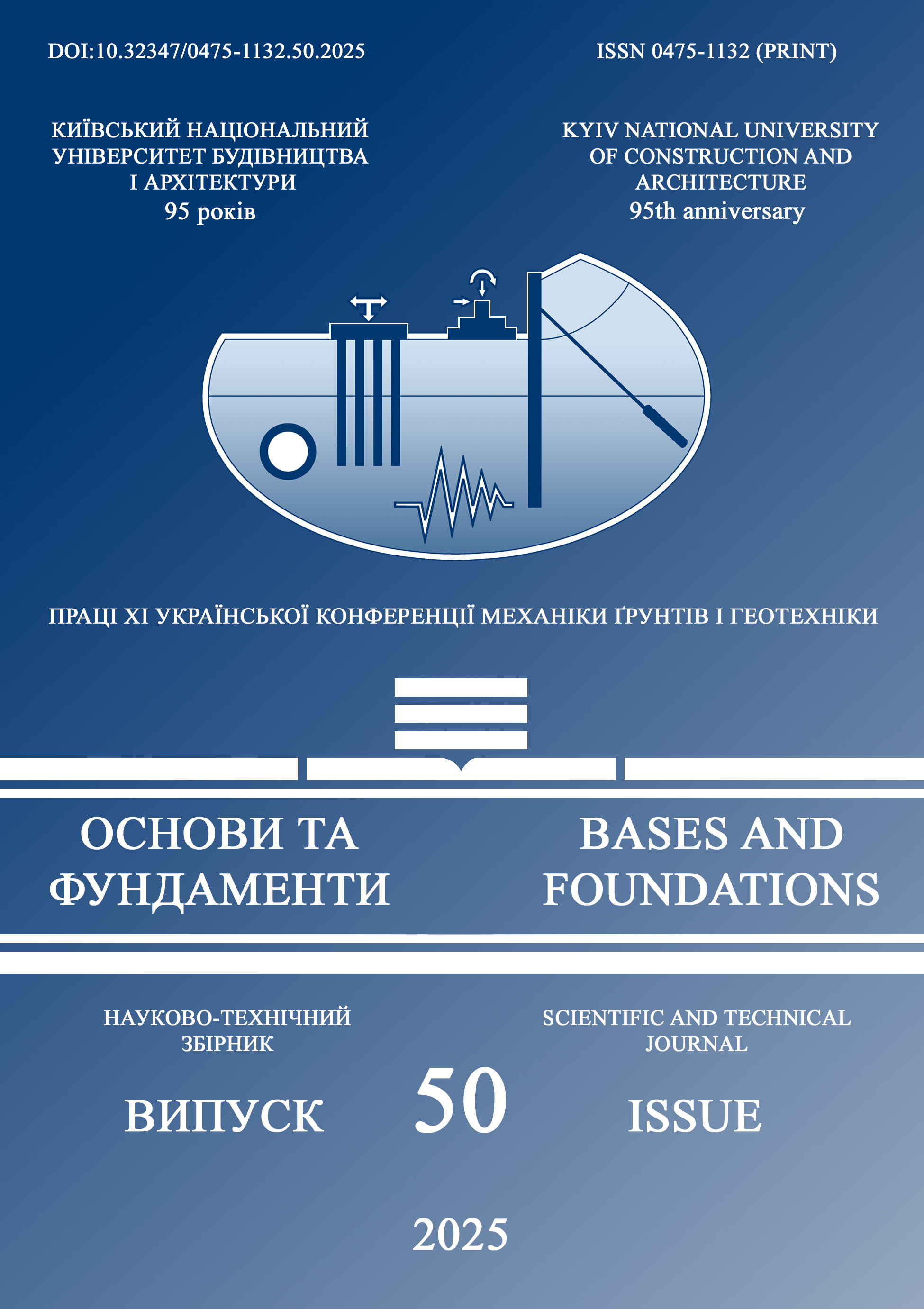Прогнозування оцінки граничного стану підсилених фундаментів
Основний зміст сторінки статті
Анотація
Тема прогнозування несучої спроможності фундаментних конструкцій є актуальна для всієї будівельної галузі, яка грає найголовнішу роль у всіх галузях країни. Метою роботи є удосконалення математичного апарату числового методу граничних елементів в прикладних дослідженнях поведінки під навантаженням підсилених фундаментів.
Механіка ґрунтів слугує теоретичною основою для розрахунків при виборі типу та розмірів фундаменту будівлі, а також при проектуванні ґрунтових споруд. Тому рівень розвитку механіки ґрунтів суттєво впливає на економічність та надійність прийнятих рішень. Інженери-проектувальники при необхідності врахування взаємодії споруди з ґрунтом стикаються з великою невизначеністю, емпірикою. Оскільки ґрунти – це дисперсні утворення, вони характеризуються значною неоднорідністю будови, суттєвою залежністю їх характеристик від рівня зовнішніх впливів, це природна субстанція.
В якості методу аналізу поставленої задачі використано сучасний числовий МГЕ, який дозволяє різко підняти рівень адекватності проектного рішення, удосконалити розрахункову схему. До практичної цінності проведених досліджень слід віднести достовірну картину графіка «навантаження-осідання» , отриманого за МГЕ для дисперсних ґрунтів будівельного майданчика для аналізу прогнозу безпечного граничного стану будівлі на підсилених фундаментах. Сучасний стан розвитку механіки ґрунтів характеризується активним переходом до нових розрахункових моделей, які більш повно відображають реальні дисперсні властивості ґрунтів. Досвід проектування фундаментних конструкцій з залученням числового МГЕ корисний для інженерів, студентів та аспірантів будівельних спеціальностей, що працюють в області механіки ґрунтів та її практичних прикладань.
Блок інформації про статтю

Ця робота ліцензується відповідно до Creative Commons Attribution 4.0 International License.
Автори, які публікуються у цьому журналі, погоджуються з наступними умовами: Автори залишають за собою право на авторство своєї роботи та передають журналу право першої публікації цієї роботи на умовах ліцензії Creative Commons Attribution License, котра дозволяє іншим особам вільно розповсюджувати опубліковану роботу з обов'язковим посиланням на авторів оригінальної роботи та першу публікацію роботи у цьому журналі. Автори мають право укладати самостійні додаткові угоди щодо неексклюзивного розповсюдження роботи у тому вигляді, в якому вона була опублікована цим журналом (наприклад, розміщувати роботу в електронному сховищі установи або публікувати у складі монографії), за умови збереження посилання на першу публікацію роботи у цьому журналі. Політика журналу дозволяє і заохочує розміщення авторами в мережі Інтернет (наприклад, у сховищах установ або на особистих веб-сайтах) рукопису роботи, як до подання цього рукопису до редакції, так і під час його редакційного опрацювання, оскільки це сприяє виникненню продуктивної наукової дискусії та позитивно позначається на оперативності та динаміці цитування опублікованої роботи (див. The Effect of Open Access).Посилання
Основи та фундаменти споруд. Основні положення: ДБНВ.2.1–10:2018. (2018) [Чинний від 2019.01.01]. К.: Мінрегіон України
Brebbia K. (1982) Applications of MGE in engineering. S. Walker.
Бойко І. П. (1985) Теоретичні основи про-ектування пальових фундаментів на пру-жньо-пластичній основі. Основи та фун-даменти: Науково-технічний збірник, 18, 11–18.
Ніколаєвський В. М.(1979) Дилатансія та закони незворотнього деформування ґру-нтів Основи фундаменти та механіка ґру-нтів: Збірник, 5, 29-31.
Mindlin R. D. (1936) Force at a point in the interior of a semi-infinite solid. Physics.
Моргун А.С. (2108) Деформативність грунту при пластичній формозміні та ди-латансії. Вінниця: ВНТУ.
Лапшин Ф.К., & Потапов С.Н. (1978) Дос-від проектування та улаштування фунда-ментів промислового корпусу із бурових паль. Основи фундаменти та механіка ґрунтів: Збірник, 5.
Osnovy ta fundamenty sporud. Osnovni polozhennia: DBNV.2.1–10:2018. (2018) – [Chynnyi vid 2019.01.01]. – K.: Minrehion Ukrainy, 36 (in Ukrainian).
Brebbia K. (1982) Applications of MGE in engineering. S. Walker.
Boyko I (1985) Teoretychni osnovy proektuvannya palʹovykh fundamentiv na pruzhnʹo-plastychniy osnovi [Theoretical foundations of the design of pile foundations on an elastic-plastic basis]. Osnovy ta fundamenty: Naukovo-tekhnichnyi zbirnyk., 18, 11-18 (in Ukrainian).
Nikolayevsʹkyy V. M.(1979) Dylatansiya ta zakony nezvorotnʹoho deformuvannya gru-ntiv [Dilatancy and laws of irreversible de-formation of soils] Osnovy fundamenty ta mekhanika gru-ntiv: Zbirnyk, 5, 29-31 (in Ukrainian)
Mindlin R. D. (1936) Force at a point in the interior of a semi-infinite solid. Physics.
Morhun A.S. (2108) Deformatyvnistʹ hruntu pry plastychniy formozmini ta dylatansiyi [Soil deformability during plastic defor-mation and dilatancy]. Vinnytsya: VNTU (in Ukrainian)
Lapshyn F.K., & Potapov S.N. (1978) Dosvid proektuvannya ta ulashtuvannya funda-mentiv promyslovoho korpusu iz burovykh palʹ [Experience in designing and installing industrial building foundations from bored piles.]. Osnovy fundamenty ta mekhanika gruntiv: Zbirnyk, 5 (in Ukrainian)
